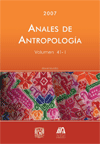Estudio de áreas de actividad en la Cueva del Indio, Durango: una aproximación interdisciplinaria
Main Article Content
Abstract
One of the most important objectives in the Archaeological Project of Cueva del Indio, Durango, is to identify activity areas based on the study of archaeological material, chemical data preserved in the sediments of the cave floor, paleobotanic information and the concern for the preservation of the site and the activity indicators present. The prehispanic settlement corresponds with the characteristics present in the Zacateca group, and it is considered as a temporary site used during the winter season associated with outdoor campsites. The chemical study was based on qualitative and semiquantitative analysis for the identification of phosphates, residues of protein, carbonates and fatty acids. The ph and color tests were done in the cave sediments. The activity areas identified were: production, storage, usage, and consumption areas.
Downloads
Download data is not yet available.
Article Details
How to Cite
Cruz Flores, S., & Ortiz Butrón, A. (2009). Estudio de áreas de actividad en la Cueva del Indio, Durango: una aproximación interdisciplinaria. Annals of Anthropology, 41(1). https://doi.org/10.22201/iia.24486221e.2007.1.361
Citas en Dimensions Service
Esta revista usa una licencia CC del tipo CC BY-NC-ND 3.0. Se maneja bajo el esquema de acceso abierto, con una licencia Creative Commons Attribution-NonCommercial-NoDerivs 3.0 Unported.
